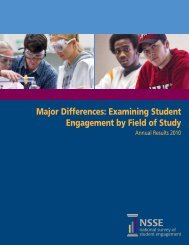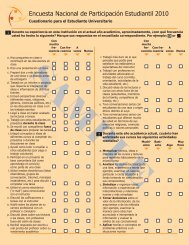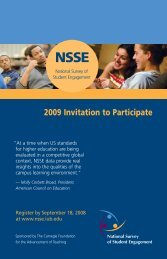Conceptual Framework and Overview of Psychometric Properties
Conceptual Framework and Overview of Psychometric Properties
Conceptual Framework and Overview of Psychometric Properties
You also want an ePaper? Increase the reach of your titles
YUMPU automatically turns print PDFs into web optimized ePapers that Google loves.
or to compare their students= performancewith data from other institutions on amutually-determined basis for purposes <strong>of</strong>benchmarking <strong>and</strong> institutional improvement.Validity, Reliability, <strong>and</strong> Credibility<strong>of</strong> Self-Report DataAs with all surveys, the NSSE relies onself-reports. Using self-reports from studentsto assess the quality <strong>of</strong> undergraduateeducation is common practice. Someoutcomes <strong>of</strong> interest cannot be measured byachievement tests, such as attitudes <strong>and</strong> valuesor gains in social <strong>and</strong> practical competence.For many indicators <strong>of</strong> educational practice,such as how students use their time, studentreports are <strong>of</strong>ten the only meaningful source<strong>of</strong> data.The validity <strong>and</strong> credibility <strong>of</strong> self-reportshave been examined extensively (Baird, 1976;Berdie, 1971; Pace, 1985; Pike, 1995;Pohlmann & Beggs, 1974; Turner & Martin,1984). The accuracy <strong>of</strong> self-reports can beaffected by two general problems. The mostimportant factor (Wentl<strong>and</strong> & Smith, 1993) isthe inability <strong>of</strong> respondents to provideaccurate information in response to aquestion. The second factor is unwillingnesson the part <strong>of</strong> respondents to provide whatthey know to be truthful information (Aaker,Kumar, & Day, 1998). In the former instance,students simply may not have enoughexperience with the institution to render aprecise judgment or they may not underst<strong>and</strong>the question. The second problem representsthe possibility that students intentionallyreport inaccurate information about theiractivities or backgrounds. Research showsthat people generally tend to respondaccurately when questions are about their pastbehavior with the exception <strong>of</strong> items thatexplore sensitive areas or put them in anawkward, potentially embarrassing position(Bradburn & Sudman, 1988).The validity <strong>of</strong> self-reported time use has alsobeen examined (Gershuny & Robinson, 1988).Estimates <strong>of</strong> time usage tend to be lessaccurate than diary entries. However, thisthreat to validity can be amelioratedsomewhat by asking respondents aboutrelatively recent activities (preferably sixmonths or less), providing a frame <strong>of</strong>reference or l<strong>and</strong>mark to use, such as theperiod <strong>of</strong> time to be considered (Converse &Presser, 1989). Such l<strong>and</strong>marks aid memoryrecall <strong>and</strong> reduce distortion by telescoping,the tendency for respondents to rememberevents as happening more recently than theyactually did (Singleton, Straits, & Straits,1993). Requesting multiple time estimatesalso makes it possible to control for outliers,those whose combined estimates <strong>of</strong> time areeither so high that the total number <strong>of</strong> hoursreported exceeds the number available for theset <strong>of</strong> activities or those that are unreasonablylow.Student self-reports are also subject to thehalo effect, the possibility that students mayslightly inflate certain aspects <strong>of</strong> theirbehavior or performance, such as grades, theamount that they gain from attending college,<strong>and</strong> the level <strong>of</strong> effort they put forth in certainactivities. To the extent this Ahalo effect@exists, it appears to be relatively constantacross different types <strong>of</strong> students <strong>and</strong> schools(Pike, 1999). This means that while theabsolute value <strong>of</strong> what students report maydiffer somewhat from what they actually do,the effect is consistent across schools <strong>and</strong>students so that the halo effect does not appearto advantage or disadvantage one institutionor student group compared with another.With this in mind, self-reports are likely to bevalid under five general conditions (Bradburn& Sudman, 1988; Br<strong>and</strong>t, 1958; Converse &Presser, 1989; DeNisi & Shaw, 1977;Hansford & Hattie, 1982; Laing, Swayer, &Noble 1989; Lowman & Williams, 1987;Pace, 1985; Pike, 1995). They are: (1) when<strong>Framework</strong> & <strong>Psychometric</strong> <strong>Properties</strong>Page 3 <strong>of</strong> 26



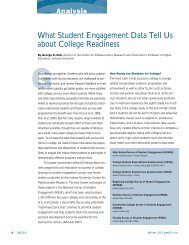

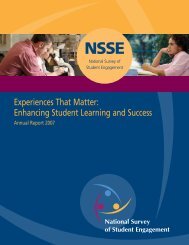
![Cuestionario para el Estudiante Universitarioâ[consent] - NSSE](https://img.yumpu.com/41728892/1/190x245/cuestionario-para-el-estudiante-universitarioaconsent-nsse.jpg?quality=85)
